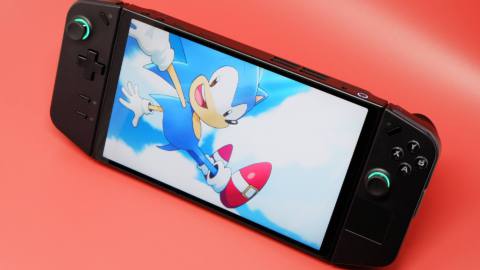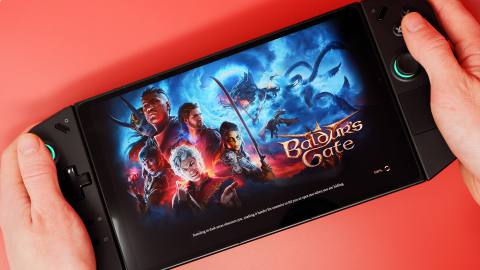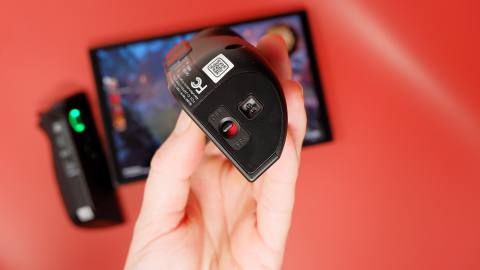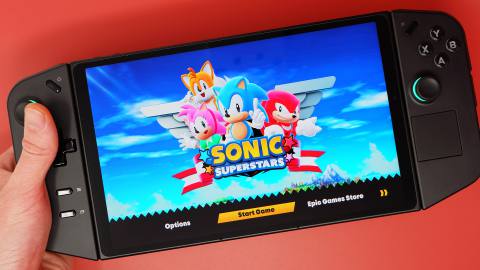Four years ago gaming handhelds were only just appearing on my radar. Today, we've multiple options from some of the biggest manufacturers around. You can add Lenovo to that list, too, as the company has put together what has to be the sleekest-looking gaming handheld I've used so far.
The Lenovo Legion Go is an awfully good-looking device. Remove it from the box and one gets the feeling of $750 well spent. It's mostly made up of an enormous 8.8-inch glossy touchscreen. This is the Go's most impressive feature by far: It's big, vibrant, and responsive.
The Go's chassis gives the impression of an almost edge-to-edge screen. It's not quite that, however, as the panel itself doesn't quite extend out to the full glossy layer on top, though it's still an impressively large and domineering screen. It's an entirely different beast to the compact Ayaneo Air 1S with a 5.5-inch screen, and once you get gaming on it, whew, it's engrossing in a way a more compact handheld can't be.
The Go's 8-inch panel is one of the largest on a PC gaming handheld today, surpassing even the Aokzoe A1 Pro we've tested previously at eight inches. Though much like the A1 Pro, the Legion Go is best enjoyed from the comfort of your own home, or at least somewhere stable enough that you can properly set it up.

Processor: AMD Ryzen Z1 Extreme
GPU: Radeon 780M (12CU | RDNA 3)
CPU: 8 cores/16 threads (Zen 4)
RAM: 16GB LPDDR5
Storage: 512GB/1TB NVMe SSD (region depending)
Display: 8.8-inch, 144Hz IPS
Ports: USB4 Type-C x2, 1x 3.5mm jack, MicroSD card reader
Connectivity: Wi-Fi 6E, Bluetooth 5.1
Battery: 49.2WHr
Weight: 854g (with controllers)
Dimensions: 40.7 x 298.83 x 131mm (with controllers)
Price: $700/£700
The Go is a significantly larger device than most handhelds I've used to date; even the Steam Deck looks pretty compact by comparison. Within the included carry case, the Go demands a lot of room inside a backpack or suitcase. Not a huge issue, but I found the Go isn't a device I decide to take outdoors often without good reason. Unlike a slimmer device that I might throw in a backpack “just in case”.
The Go isn't lightweight, either. With our top pick for the best handheld gaming PC today, the OneXPlayer OneXFly, weighs in at 580 grams, the Go's 854 grams with controllers or 640 grams without is noticeable in hand. Holding this device in just one hand while I quickly checked my phone was when I really noticed just how much weight there is to it, though the lighter controllers do help spread that out evenly once it's back in two hands.
The Go is not a device I'm prone to holding onto for lengthy game sessions. I'm setting it up on a table or desk and using the Go's clever controllers instead.
Unlike most other handhelds, the Go offers detachable controllers. These work in a similar fashion to those on the Nintendo Switch—to detach, just hold a button and pull down. To reattach, just line each one up and click into place. Due to a lack of rails like the Switch they're a little bit clunkier in action, but it's a minor issue with an otherwise incredibly useful feature. These controllers make for a little more flexibility with how you game and mean you don't have to bear the weight of the device all the time.

So, about these controllers. Lenovo made a big fuss about its FPS mode at launch. This turns the right-hand controller half into a makeshift mouse. I've tried it, but I've not really gotten along with it for gaming. I played some Baldur's Gate 3 and Frostpunk with it, but I felt like just ditching it for standard controller-style controls or connecting a Bluetooth mouse instead.
That said, and it does surprise me to say this, FPS mode is a pretty handy stand-in for a mouse when you might not have one close by. It sure beats navigating Windows via prodding the screen, and it makes games like Frostpunk much more playable. The stand you need to run FPS mode fits neatly inside the Go's carry case.
The FPS mode does mean the button layout is a little odd on the right-hand controller, however.
Yet this isn't why I like the Go's detachable controllers. No, they're key to the Legion Go's comfort thanks to the little stand on the rear of the device, much like a Switch, turning the Legion Go into one of the comfiest handhelds I've used to date.
The small stand built into the rear of the Go's chassis unfolds to keep it upright on a desk. It's adjustable, too. Unclip the controllers and you can sink back into your seat and genuinely relax while playing. This is absolutely the best way to play games like Baldur's Gate on Go—you can sink a lot of hours into either game in a single session and this means you don't have to clutch onto a hot and heavy device with sweaty palms for the duration.

You're also further away from the fan outlet, which makes for a cooler and quieter experience.
The larger screen on the Go plays to its strength while gaming with detached controllers—you can sit back and relax and retain a reasonably good view of things across an 8.8-inch screen. Any smaller and some games are more difficult to navigate from a distance. That said, I've been playing Sonic Generations on the Go and while it looks great, any game with a simpler premise is well suited to a smaller screen.
That's the thing with the Go. The specifications and screen can seem at a bit of an imbalance. It's powered by the same AMD Ryzen Z1 Extreme as the ROG Ally, which is effectively a match for the Ryzen 7 7840U processor often employed in other handhelds. It comes with an RDNA 3 GPU featuring 12 compute units, which is plenty of power for many indies and low-rent games like Sonic, and even a few big hitters that play nicely on lower-spec hardware. However, it's not going to get you far with a 2560 x 1600 resolution at 144Hz in many popular or recently released games.
You'll most likely find yourself setting the screen to a more moderate 1920 x 1200 resolution for gaming. This works out just fine, as the screen is so compact that I don't notice altogether much blurriness from running the panel at lower than native res. But of my current game rotation I only play one at 2560 x 1600, and that's World of Horror. Everything else gets relegated to the lower res to pick up performance.
Yet it's indies that I think best suit handheld gaming PCs in general. My Steam Deck is my indie machine, it's the reason I've found time to play half of the games in my backlog, and you can enjoy those games in full glory with the Go.
On the other hand, in a game such as Baldur's Gate 3, it's all about flicking as many performance switches as possible. 1920 x 1200, FSR, Low presets—you need the lot to score playable performance. Luckily some blemishes added to a game through the use of upscaling are less noticeable on the Go's compact screen.
There are no surprises when it comes to performance, however. The fundamentals of the Legion Go are very much a known quantity, thanks to AMD's widely used and excellent Ryzen mobile chip.
That said, these AMD-powered handhelds all go about thermal and power management in different ways. Lenovo has opted for a couple of modes to help with that: Power-saving mode and Performance mode. No prizes for what these do, though for performance while connected to an outlet, you'll want the Performance mode at 30W, and for pretty much everything else away from the wall, I'd go for Power-saving mode, which offers a “Balanced TDP” and tweaks the OS Power Mode to Efficiency. While Lenovo doesn't specify an exact TDP for this mode, I've measured the chip at ~15W while gaming.
In Performance mode expect some fan whirr if you're playing a demanding game. Also, temperatures tend to stabilise around the 67°C mark, whereas in Power-saving mode the Go runs around 7–10°C cooler in my experience.

✅ You're planning to use your handheld in the home: This Lenovo really is quite large and quite heavy. Though if you're mostly planning to use this device on the sofa or in the garden, it's one of the best for that.
✅ You want detachable controllers: I surprise myself with how much I like the detachable controllers on the Go. They really are great for relaxing while gaming, even on a compact 'handheld' such as this.
❌ You're hoping to game at over 1080p in the biggest games: This handheld may come with a higher resolution screen than most, and thankfully it doesn't cost any extra for it, but that higher res is best for browsing Windows or less onerous indies, not the latest and greatest major titles.
These modes are easily switched in the Lenovo software. There's a slide-out window on the right-hand side of the device with all the quick options you might need: power modes, volume, brightness, controller settings, etc. Lenovo also bundles a game launcher in with the Go, though I found myself using this less.
Now onto the most important part. Because what is the value of such a handheld if not for a good price? Thankfully, Lenovo really surprised me with the initial announcement of the Go. You can pick up the 512GB model for $700/£700, or bulk up to the 1TB model I'm reviewing here for $750. There's no 1TB model in the UK or the rest of Europe, but you could always upgrade the Go with a screwdriver and a 2230 SSD such as the Sabrent Rocket Q4 2230.
It may have been easy for Lenovo to slap a bigger price tag on the Legion Go to account for its large and high-resolution screen. Thankfully, it didn't. The Asus ROG Ally would've loomed large over the Go if it had. Seeing as Lenovo played the sensible game of price matching the Ally, the Go can compete with that device when it counts. These are similar devices, though personally the microSD card issue on the Ally still plays on my mind enough for me to settle on the Lenovo. By and large, they're pretty close.
That price also does a lot to assuage my concerns with the overly high-res screen. It can often be unnecessary on a gaming device with this sort of chip inside it, and if I felt like I was paying for a high resolution screen I'd be frustrated having to tune it down all the time. Though it doesn't feel like the screen has come at a premium, and on the off-chance it comes in handy, say in some particularly easy going game, it delivers an incredibly sharp image.
A good first stab at a handheld, then. The Go is definitely on the radar as one of the best handheld gaming PCs today. I'd love to see Lenovo keep going in this handheld space to really nail a second attempt. In the meantime, I don't think you'd be putting a foot wrong in picking up a Legion Go—just be warned, it is pretty chunky compared to some.






